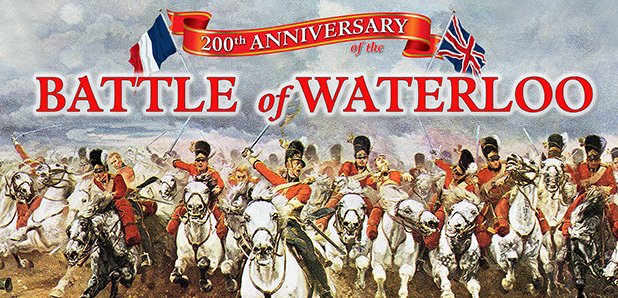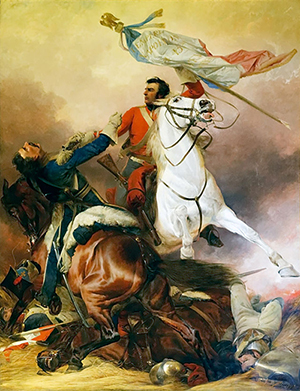Cutting-edge research for Waterloo’s 200th anniversary

Wed, 06 May 2015 14:05:00 BST
Arms and Armour Research Institute’s Paul Wilcock will lecture in London for the 200th anniversary commemorations of the Battle of Waterloo
 NAPOLEON lost the Battle of Waterloo. But in one important respect, French soldiers had an edge over their British foes. Their swords were better – more lethal and less likely to break on impact.
NAPOLEON lost the Battle of Waterloo. But in one important respect, French soldiers had an edge over their British foes. Their swords were better – more lethal and less likely to break on impact.
This is an insight from a leading expert on historic weaponry, The Revd Paul Wilcock (pictured right), who heads the University of Huddersfield’s Arms and Armour Research Institute (AARI), which has examined and analysed many of the swords and other weapons that survive from the Napoleonic Wars, including some from the epic battle that was fought on June 18, 1815.
As the 200th anniversary commemorations of the Battle of Waterloo gather pace, Mr Wilcock has been displaying weapons and delivering lectures in some highly prestigious locations – one at the Tower of London, at the invitation of the Arms and Armour Society, and one at Apsley House, the London home of the Duke of Wellington himself.
French had the edge
One of Mr Wilcock’s themes is the disparity in quality between the edge weapons brandished at Waterloo by the French and British armies. Napoleon’s men were much better served by their swords because of a system that ensured higher quality control.
 Pictured top left is a British pattern 1796 Light cavalry sabre by Reddell & Bate of Birmingham (curved slashing blade). Pictured below left is a French heavy cavalry sabre made at Klingenthal carried by the Cuirassiers at Waterloo.
Pictured top left is a British pattern 1796 Light cavalry sabre by Reddell & Bate of Birmingham (curved slashing blade). Pictured below left is a French heavy cavalry sabre made at Klingenthal carried by the Cuirassiers at Waterloo.
 “The biggest distinction is that in Britain we didn’t have a national manufactory, but individual manufacturers contracted to the government. As a result, there were often quality issues when weapons were used in the field. There are accounts of British weapons breaking on contact,” said Mr Wilcock.
“The biggest distinction is that in Britain we didn’t have a national manufactory, but individual manufacturers contracted to the government. As a result, there were often quality issues when weapons were used in the field. There are accounts of British weapons breaking on contact,” said Mr Wilcock.
For example, a letter home from E.C. Cocks, of the 16th Light Dragoons, states that: “The sword you sent me broke into pieces the first time I had it in my hand and I discovered a flaw about 22 inches from the handle”.
By contrast, France had a national manufactory at Klingenthal, near Strasbourg. It was established in the 1730s and was operational until 1966, surviving countless social and political upheavals.
“Most importantly, between 1730 and 1836, Klingenthal had the contract to produce arms for the French government,” said Mr Wilcock. “It was successful because there was an entrepreneur who was responsible for running the business, but they used military inspectors to oversee the actual work. Because of this constant tension between the business world and the military, they were heavily regulated, and the result was some very high quality products.”
The Napoleonic Wars were the last major conflict in which edged weapons featured heavily. They played an important role at Waterloo because of the huge numbers of cavalry soldiers who took part. Here too there were contrasts between the swords used by French and British soldiers.
“The French heavy cavalry swords had long, thin pointed blades, which don’t look as effective as big, slashing blades, but in practice if you are stabbed by one you are going to die, if not from wound, then from the infection. The British light cavalry swords were curved and could cause horrendous injuries, but not always death,” said Mr Wilcock.
 Exhibitions
Exhibitions
Pictured right is a British Light Dragoon pistol marked to the Kings German Legion cavalry who fought at Waterloo.
Mr Wilcock and the AARI work closely with public bodies and private collectors and in addition to his sequence of lectures, he has also played a role in curating exhibitions of Waterloo weaponry, including swords, pistols and other artefacts. One has been mounted at Apsley House and the Wellington Arch in London and runs until November. Another can be seen at the National Army Museum North, based at Bankfield Museum, Halifax. This will include a British army shako – military headgear – that displays a bullet hole. Also on display will be the actual Waterloo Medal that was presented to the Duke of Wellington himself.
“Waterloo changed the face of Europe, but the final result was much closer than most people realise. If the battle started when it should have done, two hours earlier, and if the weather not been so inclement, so the French had to drag guns through mud, it might have had a different outcome,” said Mr Wilcock.
As well as weaponry, he has been investigating accounts from survivors among the 300,000 soldiers who took part in the battle and has included some of these passages in his lectures. They reveal the gruesome reality of Waterloo...
 “One made a thrust at my groin. I parried it off and cut him down through the head. A lancer came at me – I threw the lance off and cut him through the chin and upwards through the teeth. Next a foot soldier fired at me and then charged me with a bayonet, which I also had the good luck to parry and then I cut him down through the head. That ended it!” – Sergeant Charles Ewart, 2nd Royal North British Dragoons (Scots Greys), on his experience capturing the eagle of the 45th Foot at Waterloo. (Pictured left is the portrait "Richard Ansdell — The Fight For The Standard" by Eric Gaba, Wikimedia Commons user Sting. Licensed under CC BY-SA 3.0 via Wikimedia Commons. This painting portrays the moment Sergeant Charles Ewart captured the eagle of the 45th Foot at Waterloo.)
“One made a thrust at my groin. I parried it off and cut him down through the head. A lancer came at me – I threw the lance off and cut him through the chin and upwards through the teeth. Next a foot soldier fired at me and then charged me with a bayonet, which I also had the good luck to parry and then I cut him down through the head. That ended it!” – Sergeant Charles Ewart, 2nd Royal North British Dragoons (Scots Greys), on his experience capturing the eagle of the 45th Foot at Waterloo. (Pictured left is the portrait "Richard Ansdell — The Fight For The Standard" by Eric Gaba, Wikimedia Commons user Sting. Licensed under CC BY-SA 3.0 via Wikimedia Commons. This painting portrays the moment Sergeant Charles Ewart captured the eagle of the 45th Foot at Waterloo.)
- “In leading the 3rd Squadron in the charge I was run through the body from the right side to the naval, about 6 inches. When the point of the sword came out…my antagonist, instead of withdrawing his sword from my body altogether, drew it up a little and made another thrust into the cavity of my chest. I was led off the field, faint and sick ... I must mention that I received my wound in the act of uplifting my arm and making a cut at the head of my antagonist on his near side. He wore a brass helmet, and the blade of my sabre broke in two on it, which left me quite at his mercy.” – Thomas Brotherton, 14th Light Dragoons, on being wounded by a French heavy cavalry sabre
- “They found us very dangerous with our sabres. We always thrust with the point of our sabres while they always cut with their blade, which was three inches wide. Consequently, out of every 20 blows aimed by them, 19 missed. If however the edge of the blade found its mark only once, it was a terrible blow and not unusual to see an arm cut clean from the body.” – Captain Charles Parquin, 20th Chasseurs a Cheval, commenting on the difference between the British light cavalry sabre and the French heavy cavalry sabre
- “Please order me a new sabre and belt from Prosser, it should be roomy in the handle and not too heavy at the point. Will you be so good as to have it proved.” Six months later in a further letter... “By the way, I almost forgot to mention that the sword you sent me broke into pieces the first time I had it in my hand and I discovered a flaw about 22 inches from the handle.” E.C. Cocks, 16th Light Dragoons, on the problems he found with his sabre
The sabres and pistol pictured above are on display in the Wellington Arch, London, until November.







